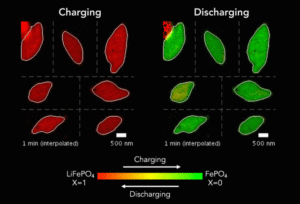In the bad old days when the only batteries suitable for traction applications were flooded lead-acid and Ni-Cd types, the battery was the least efficient component of an EV powertrain, routinely delivering back only 50-70% of the amp-hours that went into charging it (aka the Coulometric efficiency). When you knew you were going to be… Read more »
Search Results Found For: "Hyster"
Regenerative braking: A closer look at the methods and limits of regen
All motors are generators, the old saying goes, with the caveat that few types are equally good at both modes of operation, and some are downright awful as generators (a classic example being the single-phase shaded pole induction type, used in myriad small appliances the world over). Fortunately, both types of AC motor commonly used… Read more »
Iron trifluoride cathode could greatly increase energy density
Researchers from the University of Maryland and the DOE’s Brookhaven National Laboratory have developed a cathode material containing iron trifluoride (FeF3) that they say could triple the energy density of Li-ion batteries. Their research was published in Nature Communications. “Compared to the large capacity of the commercial graphite anodes used in lithium-ion batteries, the capacity of the cathodes is… Read more »
Researchers achieve extended cycle life using molybdenum compound as protective anode layer in Li-S batteries
Researchers at The University of Texas at Dallas have used two-dimensional molybdenum disulfide (MoS2) as a protective layer for Li-metal anodes to greatly improve the performance of Li-S batteries. In “2D MoS2 as an efficient protective layer for lithium metal anodes in high-performance Li–S batteries,” published in Nature Nanotechnology , the researchers report that such a use of MoS2 results in… Read more »
New X-ray microscopy technique reveals the secret life of batteries
In pursuit of their quest for more capable batteries, scientists are searching for better ways to observe battery particles as they charge and discharge in real time. A new technique developed at Berkeley Lab’s Advanced Light Source is providing researchers with nanoscale images of the electrochemical reactions that make lithium-ion batteries do their thing. In… Read more »
Toyota researchers work with Brookhaven National Lab to investigate magnesium batteries
Toyota researchers are collaborating with the Center for Functional Nanomaterials (CFN) at the DOE’s Brookhaven National Laboratory to probe molecular structures and track chemical reactions in magnesium batteries. “Issues related to cost, power, energy density, and durability of Li-ion batteries have slowed their implementation in large-scale applications, such as electric and hybrid vehicles,” said Toyota… Read more »
The challenges of battery state of charge measurements
Your BMS’s fuel gauge is lying to you. Here’s why that’s not a big deal. Battery management systems (BMSs), and the fuel gauges in them, are a part of daily life for almost everyone. You’ll find them in vehicles, laptops, cell phones, grid-attached energy storage – basically, anything that does work and needs to be plugged in,… Read more »
Prototype battery explosion injures two at GM research center
Two employees were hurt and 80 were evacuated following an explosion at the GM Tech Center in Warren, Michigan this morning.











